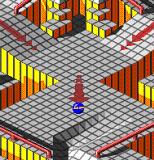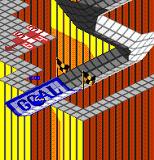Since the days of the original Game Boy, old-school arcade games have been a wonderful resource for up-and-coming platforms. They provide simple, tried-and-true formulas that aren't technically taxing and have a certain amount of built-in recognition. Atari's Marble Madness, which first appeared in arcades in 1984, has since appeared on just about every platform from the Commodore 64 to the Sega Game Gear. Now, 20 years after its debut, you can play Marble Madness on your mobile phone--unfortunately, you just can't do it very well.

If you're not familiar with this arcade classic, the concept behind Marble Madness is simple. You're given direct control over a little blue marble, and are asked to roll it through an obstacle-laden labyrinth, passing the finish line before the timer runs out. The game puts more of an emphasis on physics than actual pathfinding, and your ability to manage the momentum of your marble while avoiding evil black marbles; pools of acid; surreal, jumpy marble-eating monsters; and punishing environmental obstacles, all while negotiating some particularly narrow, serpentine pathways, is of the utmost importance. Despite there being only six levels in Marble Madness, the game has always had considerable lasting appeal, simply because each level is incredibly well designed, and because the game is extremely hard.
But the poorly implemented control scheme in this mobile port makes the game too hard. The biggest issue is that this version has only four-way control, which simply does not allow for the amount of finesse you need to make your way through most of the levels. The implementation is really weird, too. Pressing up makes you go up and to the left, pressing right makes you go up and to the right, pressing down makes you go down and to the right, and pressing left makes you go down and to the left. It's really counterintuitive. It requires you to do ridiculous things like rocking back and forth between two directions quickly just to move straight up or down. The original arcade version of Marble Madness used a trackball--probably one of the most obvious and intuitive control-design decisions ever--but even the NES port got by fine with an eight-way D pad, something that could've easily been accomplished here with the standard 12-key telephone pad. Even worse, the game seems to have been sped up a bit, which makes the already challenging gameplay even harder to manage.

The poor controls are really heartbreaking, because otherwise this is an almost pitch-perfect port of Marble Madness for Series 60 phones. The ray-traced isometric graphics are still sharp, and the environments are virtually arcade-perfect. The moving parts have been simplified a bit for the size and resolution of a cell-phone screen, but they do a great job of capturing the spirit of the original. The music, which has always been one of the more striking aspects of Marble Madness, sounds surprisingly great here. There are some goofy loops, but the synthesized sounds are true to the source, and they match the sterile, surreal look of the game.
That the presentation of the mobile version of Marble Madness is executed so well makes the maddeningly obtuse controls that much more heartbreaking. If you're willing to put up with a fair amount of frustration to relive this arcade classic on your mobile, you might get something out of Marble Madness. If you don't have the nostalgia, all you'll have is the frustration.